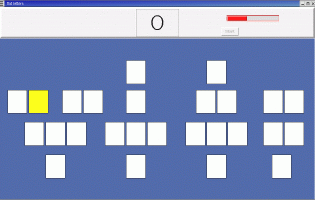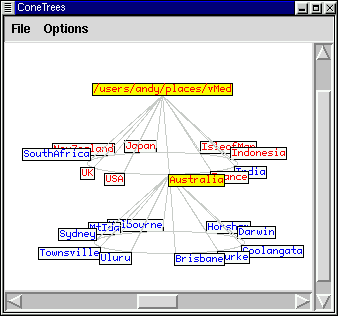Current Projects: 2D versus 3D GUIs for file and document
managements.
Revisiting 2D vs 3D Implications on Spatial Memory
Prior research has shown that the efficient use of graphical user interfaces strongly depends on
human capabilities for spatial cognition. Although it is tempting to believe that moving from
two- to three-dimensional user interfaces will enhance user performance through natural support
for spatial memory, it remains unclear whether 3D displays provide these benefits. An experiment
by Tavanti and Lind (2001) provides the most compelling result in favour of 3D.
Their
participants recalled the location of letters of the alphabet more effectively when using a 3D
interface than when using a 2D one. The experiment reported in this paper
is based on Tavanti
and Lind's, but it controls some previously uncontrolled factors. The results strongly suggest
that the effectiveness of spatial memory is unaffected by the presence or absence of
three-dimensional perspective effects in monocular static displays. They also show that user
interface items are more effectively memorised when personally meaningful and visually
distinctive.


Co-researcher (email): Bruce McKenzie
Evaluating the Effectiveness of Spatial Memory in 2D and 3D
Physical and Virtual Environments
User interfaces can improve task performance by exploiting
the powerful human capabilities for spatial cognition. This
opportunity has been demonstrated by many prior
experiments. It is tempting to believe that providing greater
spatial flexibility---by moving from flat 2D to 3D user
interfaces---will further enhance user performance.
This paper describes an experiment
that investigates the
effectiveness of spatial memory in real-world physical
models and in equivalent computer-based virtual systems.
The models constrain to varying degrees the user's freedom
to use depth and perspective in spatial arrangements of
images representing web pages. Results show that the
subjects' performance deteriorated in both the physical and
virtual systems as their freedom to locate items in the third
dimension increased. Subjective measures reinforce the
performance measures, indicating that users found
interfaces with higher dimensions more `cluttered' and less
efficient.
3D or Not 3D? Evaluating the Effect of the Third Dimension in a
Document Management System
Several recent research systems have provided interactive
three-dimensional (3D) visualisations for supporting
everyday work such as file- and document-management.
But what improvements do these 3D interfaces offer over
their traditional 2D counterparts? This
paper describes the
comparative evaluation of two document management
systems that differ only in the number of dimensions used
for displaying and interacting with the data. The 3D
system is heavily based on Robertson et al.'s Data
Mountain, which supports users in storing, organising and
retrieving `thumbnail' representations of documents such
as bookmarked web-pages. Results show that our subjects
were faster at storing and retrieving pages in the display
when using the 2D interface, but not significantly so. As
expected, retrieval times significantly increased as the
number of thumbnails increased. Despite the lack of
significant differences between the 2D and 3D interfaces,
subjective assessments showed a significant preference for
the 3D interface.
An Evaluation of Cone Tree Interfaces.
Cone Trees are an appealing interactive 3D visualization technique for
hierarchical data structures. They were originally intended to
maximise effective use of available screen space and to
better exploit the abilities of the human perceptual system. Prior
work has focused on the fidelity of the visualization rather
than providing empirical user studies. This
paper describes the
design, implementation and evaluation of a low-fidelity animated and
rapidly interactive 3D cone tree system.
Results of the evaluation show that our subjects were
slower at locating data using cone trees than when using
a `normal' tree browser, and that their performance deteriorated
rapidly as the branching factor of the data-structure increased.
Qualitative results, however, indicate that the subjects were
enthusiastic about the cone tree visualization and that they felt it
provided a better `feel' for the structure of the information space.

To my home page




